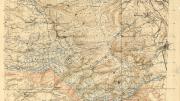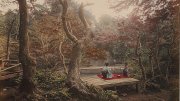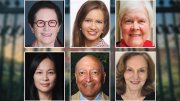2014 Centennial Medal Citations
Bruce Alberts, AB ’60, PhD ’66, biophysics
It would be easy to begin a testimonial for Bruce Alberts with a list of his achievements as an international advocate for science. As head of the National Academy of Sciences, as a special presidential envoy, and as editor of Science magazine, his influence has reached to the highest levels of global policy.
But to follow Alberts’s own inclination, it might be best to start locally.
In the early 1980s, when he was already a prominent biochemist at the University of California, San Francisco, his wife, Betty, was a PTA president in the city’s public school system, where their children were enrolled. Listening to school board discussions, Alberts was struck by the glaring disparity in resources between the city’s schools and the wealthy university in their midst. So he recruited David Ramsay, then vice chancellor at UCSF, and launched a massive effort to support the schools, transferring equipment, pedagogical resources, and people — some 300 graduate students and postdocs a year — under an umbrella organization called the UCSF Science and Health Education Partnership, now an internationally recognized model.
Thus began what could be regarded as Alberts’s second career, one committed to improving the quality of science education in US schools and connecting the rich resources of academia with on-the-ground reform efforts. He wanted to rescue science education from the repetitive drills that dampen excitement; after all, the projects that thrilled him as a student — learning about television by taking apart a TV set in eighth grade, contributing to publishable discoveries as an undergraduate in Paul Doty’s Harvard lab — were experimental and inquisitive, driven by his own curiosity, not by memorization.
Alberts had spent a decade at Princeton before arriving at UCSF in 1976, winning acclaim as a teacher, a researcher who illuminated the mechanisms of DNA replication, and one of the original authors of The Molecular Biology of the Cell, the preeminent textbook in the field. But from his earliest days, even as his energies could have been consumed by his expanding career, “Bruce was committed to building a scientific community larger than his own laboratory,” says Marc Kirschner, Enders University Professor at Harvard.
He “had a deeply held conviction that universities like UCSF had the capacity, indeed a duty, to help improve science education in our schools by forming partnerships between faculty and teachers,” agrees Ramsay, now UCSF emeritus professor of neurology.
Elected to two 6-year terms as president of the National Academy of Sciences, Alberts spurred the creation of national standards for K-12 science education and worked to bring science literacy and leadership to the developing world. He expanded that work as one of the first three Science Envoys tapped by President Obama to promote science in Muslim-majority nations; in that role, he worked extensively in Indonesia to establish a merit-based funding system for the sciences, comparable to the National Science Foundation. “Bruce Alberts is truly a citizen of the world,” says Nobel Prize winner Ahmed Zewail of the California Institute of Technology, a fellow Science Envoy.
As editor-in-chief of Science, Alberts was able to assess reform efforts and policy advances around the world. He “brought a unique set of attributes,” to the role, says Alan Leshner, chief executive officer of the American Association for the Advancement of Science, including “his passion for improving science education, the respect of top scientists throughout the world, and his ability to build rapport and trust with leaders in China, India, and Indonesia.”
Indeed, “Bruce Alberts is one of the most admired figures in American science,” says Richard Losick, Cabot Professor of Biology. He has used his several bully pulpits “to promote evidence-based approaches to science education, inspiring me and countless other colleagues across the country to devote ourselves as much to teaching effectively as to doing science.”
His career, says Marc Kirschner, “can be best characterized as combining the highest standards of science with the strongest commitment to education and a total devotion to public service. There is nothing that Bruce would not do to advance these causes, and there is nobody else in the US today who has done so much, from the most fundamental level of mentoring young scientists and students to the most exalted.”
Bruce Alberts, for your dedication to improving science education throughout the world, and for your visionary leadership of science policy on the national and global stage, we are proud to award you the 2014 Centennial Medal.
Keith Christiansen, PhD ’77, fine arts
The story of Keith Christiansen’s rise to prominence as one of this country’s most esteemed museum curators begins, appropriately enough, with an artistic flourish. Waiting in line at the bank, on his last day of a research trip to Florence in 1977, the young art historian ran into John Pope-Hennessy, who had just resigned as director of the British Museum. The two had met after a lecture at Harvard and encountered one another occasionally in Florence; on this day, Pope-Hennessy revealed that he was moving to the Metropolitan Museum of Art and invited Christiansen to join his staff. As Christiansen told the magazine ARTnews earlier this year, he seized the chance. “My one question,” he said, “was ‘Do you think this is longer than a one-year opportunity?’”
Thirty-seven years later, with the Met having answered loudly in the affirmative, the art world has been deeply enriched by that encounter, and Christiansen holds the post named for the man who brought him on board. As John Pope-Hennessy Chairman of European Paintings, he oversees the Met’s world-renowned collection of Old Masters — seven centuries of individual masterpieces and cultural monuments. Christiansen has organized these treasures into “watershed exhibitions on topics as diverse as Mantegna, Tiepolo, Caravaggio, Poussin, and 15th-century Siena,” revealing a “remarkable curiosity and intellectual scope,” says Harvard curator Stephan Wolohojian.
Last year, Christiansen unveiled the first major renovation of the Met’s European galleries since 1972. The reinstallation creates breathing room, injects historical and geographical coherence, and offers new opportunities for discovery, as the New York Times wrote last May, crediting him with “brilliantly orchestrat[ing] the collection as a play of dramatic vistas, visual lineups of images — seen around corners or over distances — that pull you forward in time and immerse you in textured layers of European culture.”
Most important, Christiansen was able to expand the number of paintings on view from 450 to more than 700, giving due prominence to the Met’s magnificent collection — now enhanced by his own wise acquisitions. “Keith Christiansen is in charge of the outstanding collection in America,” says his early Harvard mentor, James Ackerman. “The small Duccio Madonna is my favorite, but the number of great paintings acquired during his tenure is extraordinary.”
Met curator Andrea Bayer recounts how “the qualities that we most admire about Keith — his sure eye; his belief that we must always attempt to establish the past history of a work of art and understand it as a physical object; his love of music and its intersection with the visual arts; his sense of fun when working with like-minded colleagues; and an unusual ability to write for both scholarly peers and the public — all descended upon me like an avalanche when I began working with him in 1990, on an exhibition about a rediscovered Caravaggio, The Lute Player. I first witnessed then Keith’s ability to bring to life the work of art and the period in which it was made through a deep empathy with artists and their sources of inspiration.”
For Christiansen, art is the greatest learning experience. “Keith is simply a great teacher — and I have never taken a class with him!,” says his friend, the prominent private collector Jon Landau. “When we have looked at art together, I have always come out of the church, or palazzo, or museum with more knowledge, insight, and visual sensitivity than when I went in.”
Asked to describe Christiansen’s contributions, his longtime boss, former Met director Philippe de Montebello, offered a whimsical summation:
“What would be an antonym for Keith Christiansen, I asked myself? Three came to mind: obsequious, guarded, and indifferent.
It follows that I never needed to ask Keith what he thought about a picture or an issue, for I was never in doubt. If an issue, his opinion was offered with occasionally distressing candor and only the slightest nod to deference. This is why it counted for so much.
If a picture, well, there could be no doubt; so physically, almost operatically, did he punctuate his enthusiastic dithyrambs with grand gestures – and bright green socks to match.
Keith’s walking stride is so long he is a step ahead of most of us — and that is as good a metaphor as any for Keith.
Keith Christiansen, for your remarkable stewardship of one of the world’s preeminent artistic collections, and for communicating the grandeur of art with boundless energy, wise insight, and good humor, we are proud to award you the 2014 Centennial Medal.
Judith Lasker, PhD ’76, sociology
It is rare in academia for an eminent scholar to be as personally cherished — by undergraduates, graduate students, and faculty at all levels— as is Judith Lasker. But then, Lasker has always combined the personal and the intellectual, viewing her academic work as intimately connected to the real world and to the emotional lives of those around her. Through unique studies of experiences of pregnancy loss, infertility, and chronic illness, to her current research on international volunteerism, “Judith Lasker has consistently been using a rich sociological imagination,” says Barbara Katz Rothman, professor of sociology at the Graduate Center of the City University of New York. “She connects troubles to issues, individual concerns to larger social problems – and engages with the search for solutions. Her work truly is a contribution to both our scholarship and our humanity.”
Judith Lasker is N.E.H. Distinguished Professor of Sociology at Lehigh University. Through the 1980s and beyond, she undertook what proved to be a groundbreaking exploration of women’s health and reproductive lives. Her first book on the subject was When Pregnancy Fails: Families Coping with Miscarriage, Ectopic Pregnancy, Stillbirth and Infant Death. From that work, she developed a quantitative tool to assess the effects of pregnancy loss, called the Perinatal Grief Scale, now widely used, and she conducted domestic and international studies that made a major contribution to the literature on grief and bereavement. Later in that same decade, she published In Search of Parenthood: Coping with Infertility and High Tech Conception, part of a body of work exploring the social and ethical dimensions of new reproductive technology. Her work on those subjects “was influential well beyond sociology, in global health,” says medical anthropologist Arthur Kleinman, Rabb Professor at Harvard.
She began to explore the sociological meanings of chronic illness when her friend Ellen Sogolow, a former research scientist with the Centers for Disease Control, contracted a rare liver disease. As Sogolow recounts, Lasker immediately did two things: she offered to be a living donor and she tackled the problem scientifically. In Sogolow’s words, Lasker “partnered with patient groups and hospitals to amass the single largest international sample of persons with this rare disease ever studied from a social sciences perspective. In the following years, while my contribution was less over time, she completed this work and published many papers that gave new attention to a rare disease, and led to new understandings of the powerful roles of family and friends as well as health care providers in management of chronic illness.”
After exploring issues related to alternative currencies, social capital and health, and community-building, some of which resulted in her book Equal Time, Equal Value, Lasker has returned to a topic that has interested her since her Harvard days — global health, and particularly women’s health. In a forthcoming book, she is exploring the impact of short-term American volunteering in international health-care settings, assessing the effectiveness of this growing trend.
“Judy and I had the good fortune to be in Ezra Vogel’s comparative international sociology program, which celebrated dissertation research in Africa, the Middle East, the USSR, and Asia,” recalls Mary-Jo DelVecchio Good, professor of global health and social medicine at Harvard Medical School. “Judy went to the Ivory Coast; I went to Azerbaijan, Iran. During our dissertation writing, we exchanged stories from the field, including hair-raising ones. Judy, always compassionate and caring, devoted her life’s work to women’s health.”
“Judy is the complete professor,” says her Lehigh colleague, Professor James McIntosh, one of many colleagues to praise her university role. She is “an excellent teacher-professor in the best sense of the phrase. She determinedly pursues answers to serious questions in her research, and at the same time brings numbers of students into the tent of the scholarly process.”
Her friend Ellen Sogolow provides an apt summary of this unique scholar. “From her teaching and research, Judy’s legacy will span generations. From her personal strength, her reach already is vast, in ways that perhaps science does not measure. Dr. Judith Lasker shines a bright light on how very much one person can accomplish with one lifetime.”
Judith Lasker, for never forgetting the human impact of your scholarly research, and for selflessly supporting your students and colleagues in their academic, professional, and personal development, we are proud to present you the 2014 Centennial Medal.
Leo Marx, SB ’41, PhD ’50, history of American civilization
It is perhaps the highest honor for a scholar: A line of inquiry that you developed, tracing connections previously uncharted, becomes a book that changes your field, spawns new ways of thinking, captures the Zeitgeist, and yet remains startlingly contemporary over the decades.
Such was the trajectory of ideas first articulated by Leo Marx in his Harvard thesis and then in his seminal work of American studies, The Machine in the Garden. Exploring tensions between the pastoral and the industrial in Hawthorne, Emerson, Thoreau, and Melville, the book seemed to predict America’s current unease about the role of technology, the degradation of the environment, and its own sense of possibility. It has been in print continuously in the fifty years since its debut in 1964.
“At this point in American history, it is unimaginable to talk about anything of substance without talking about technology, the environment, and the American dream,” says Rosalind Williams, Bern Dibner Professor of the History of Science and Technology at MIT. “This book was out in front. It was about environment and technology before those two words became defining words of American consciousness.”
Leo Marx is Senior Lecturer and William R. Kenan Professor of American Cultural History Emeritus in the Program in Science, Technology, and Society at MIT. He arrived there in 1976, after stints at the University of Minnesota and Amherst College, to help found the Program in Science, Technology, and Society.
His body of writings has helped to define an area of American studies concerned with the intermingling of science, technology, literature, and culture. His books — which include The Pilot and the Passenger and the edited collections Does Technology Drive History? (with Merritt Roe Smith), ) and Progress: Fact or Illusion? (with Bruce Mazlish) — raise fundamental questions about American identity.
“Few scholars can claim to have invented a new field, fewer still to have done so with a work that still breathes freshness after fifty years. Leo Marx has done both,” says Sheila Jasanoff, Pforzheimer Professor at Harvard. “His Machine in the Garden is a foundation stone of American cultural studies and of science and technology studies, essential reading for anyone who wants to understand American thought about the relations between nature and technology.”
Marx’s legacy is as a “great scholar, a great teacher, and an even finer human being,” in the words of Roe Smith, MIT’s Cutten Professor of the History of Technology — an assessment that is widely shared. “When I arrived at Amherst College in 1974, Leo Marx was already a distinguished scholar and teacher,” recalls Austin Sarat, Cromwell Professor of Jurisprudence and Political Science at Amherst. “He also was a leader on the faculty, exemplifying an intellectual acumen and breadth of interest that set a standard for his colleagues. I recall many conversations with my peers during which we marveled at Leo’s example, wondering all the while whether any of us would ever be able to be like Leo. But we all also knew that Leo was truly one of a kind!”
That has remained true throughout his career. His longtime friend Jill Ker Conway, a colleague in the program in Science, Technology and Society in the late 1980s, recalls his distinct strengths as a teacher. “STS was a graduate program, and most of its students whose training was scientific struggled initially with the language of philosophy, history, and sociology. Leo is a master teacher who can translate disparate ways of thinking with such fluency and ease that even the most anxious students soon mastered ways of thinking such as deconstruction, and could be overheard arguing vigorously over the finer points. It was always a delight to observe his impact on students, because he made it clear that the notion of the ‘Two Cultures,’ popularized by C. P. Snow, did not exist for him. I never ceased to be astonished by the breadth of his interests, which crossed a broad sweep of disciplines.”
That breadth of scope helped fuel the deep and continuing impact of his masterwork. “Leo Marx’s Machine in the Garden reads as freshly relevant in 2014 as it did in 1964,” says Joyce Chaplin, Phillips Professor of Early American History at Harvard. “As realization dawns that concerns about the environment and of the impact of human technology upon it are problems that will not go away, it is extraordinary to realize that Marx put nature and technology into the study of American culture from the start. He was right then, and he’s right now.”
Leo Marx, for your foresight in predicting the challenges of contemporary American life, and for your wisdom in helping generations of students make sense of those challenges, we are proud to award you the 2014 Centennial Medal.





